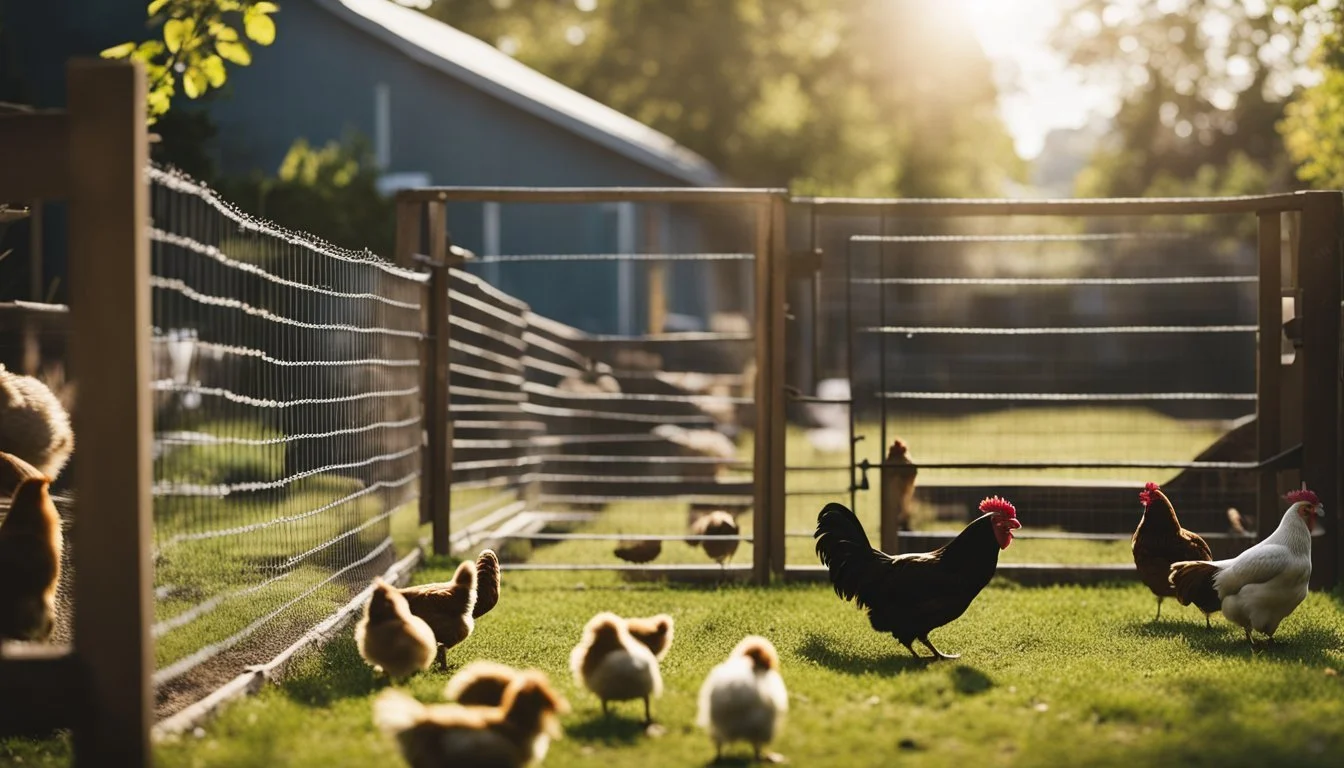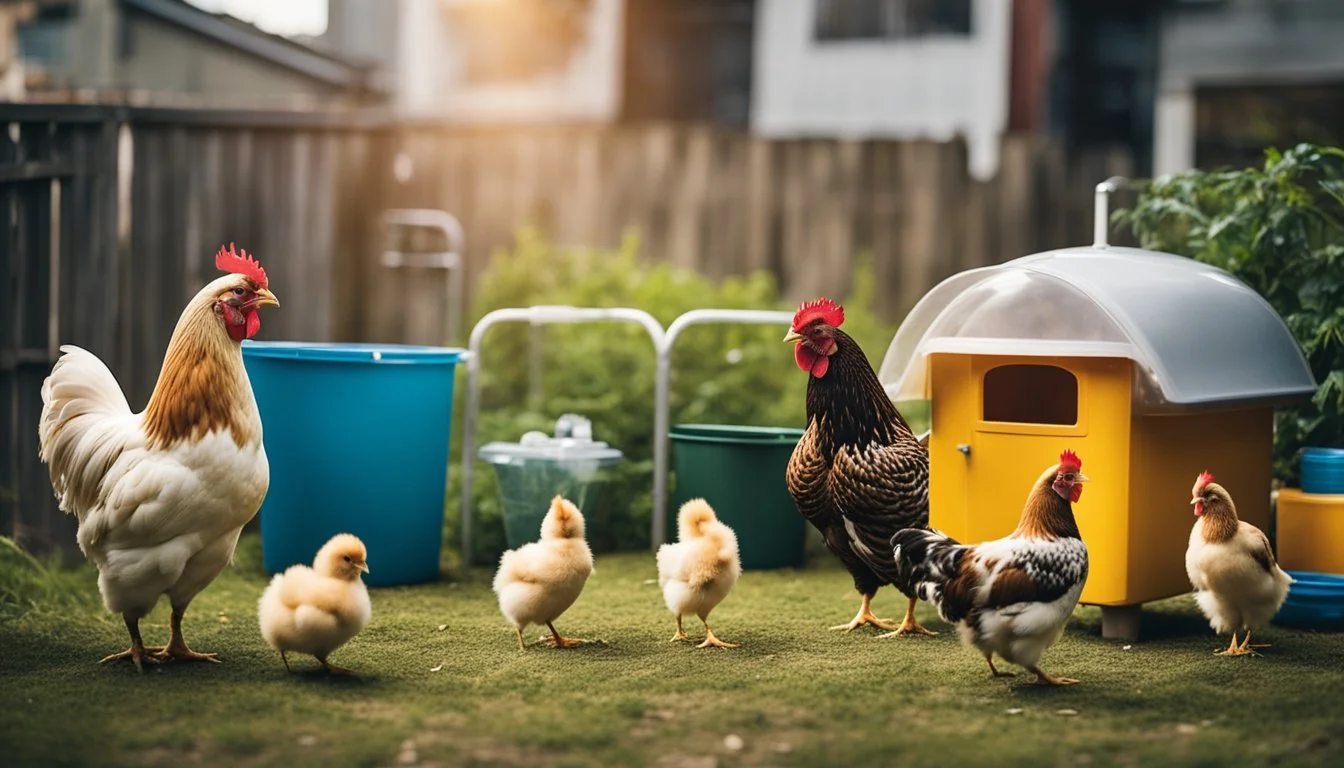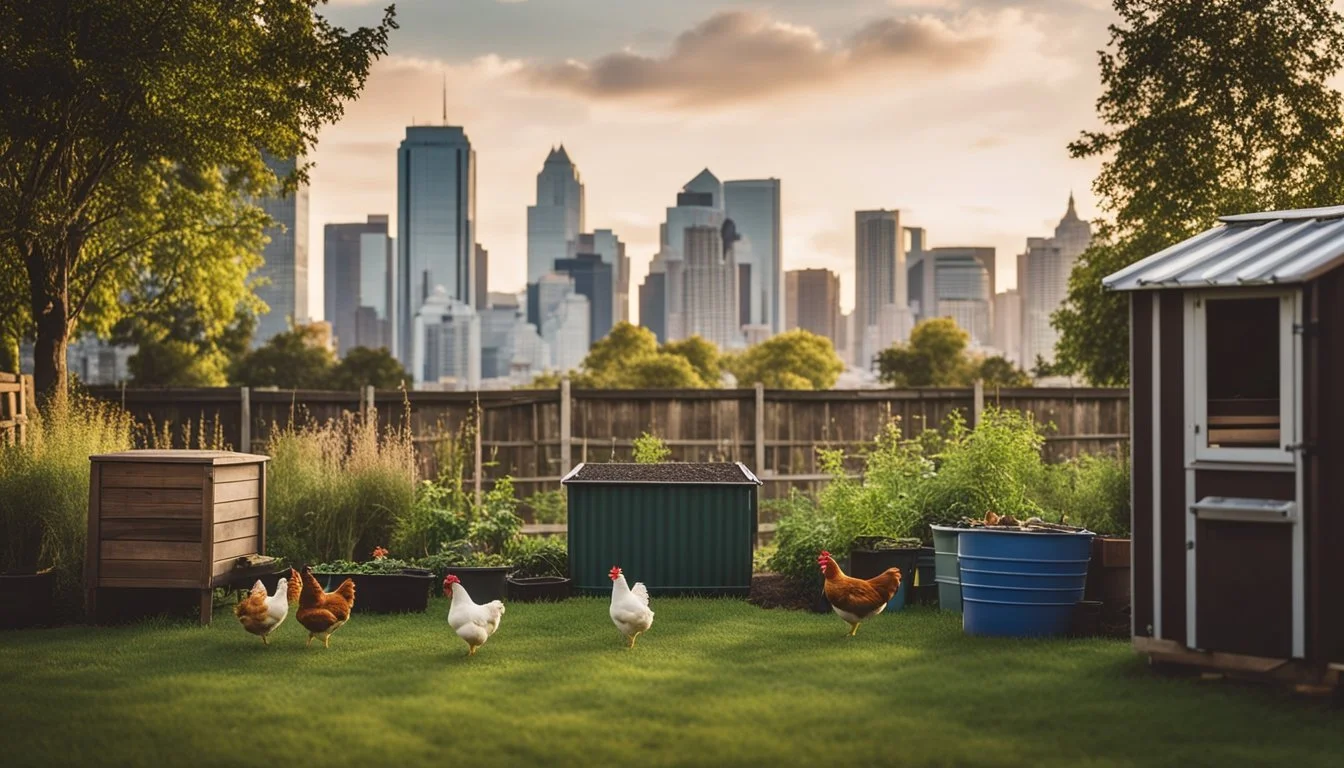10 Questions to Ask Before Getting Urban Chickens
Essential Insights for Prospective Chicken Keepers
Raising urban chickens has become a popular trend among city dwellers looking to enjoy fresh eggs and a touch of rural life in their backyards. This endeavor can be both rewarding and challenging, requiring careful consideration and preparation to ensure the well-being of the birds and compliance with local regulations. Understanding the essential factors and potential obstacles before diving into urban chicken keeping is crucial for a successful start.
City ordinances and homeowners' association rules can significantly impact your ability to raise chickens. Moreover, selecting the right breed, preparing a suitable living environment, and maintaining hygiene are all key components that prospective chicken keepers must address. Asking the right questions before getting urban chickens can save time, money, and effort while providing a smoother and more enjoyable experience.
1) Is My Area Zoned for Urban Chickens?
Before deciding to raise chickens, checking local zoning laws and ordinances is crucial. Many urban areas have specific regulations regarding the keeping of poultry.
Local zoning laws can dictate the number of chickens allowed or even prohibit keeping them altogether. These laws are often available on your city or county's official website.
Homeowners in neighborhoods with Homeowners’ Associations (HOAs) should also review the HOA rules. Some HOAs may have additional restrictions beyond local laws.
It's important to verify if roosters are permitted, as they can be noisy and are often not allowed in urban areas.
Consulting local regulations will ensure that your new hobby is in compliance with all relevant laws and guidelines. Checking these regulations early can save time, money, and potential legal issues.
2) How Much Space Do Chickens Need?
Each chicken requires specific amounts of space to thrive. In a coop, it's generally recommended to provide at least three to four square feet of space per adult bird. Adequate space inside the coop helps in preventing overcrowding and stress among the chickens.
For bantam chickens, which are smaller, it is sufficient to allocate two square feet per bird. Nesting boxes should be about 12x12 inches and offer a quiet, dark place for hens to lay eggs. Each nesting box can accommodate up to four hens.
Chickens also need outdoor space to roam and engage in natural behaviors. A run or outdoor pen should have at least eight to ten square feet per bird. For larger breeds, a bit more space may be required to keep them comfortable and active.
Providing sufficient space for perch is essential too. Roosting bars should allow for about six inches of room for each chicken. Keeping the coop and outdoor areas clean and well-maintained ensures a healthy environment for the birds.
3) What Breed of Chicken is Best for Me?
Choosing the right breed of chicken depends on several factors, including egg production, temperament, and adaptability to urban environments.
Some breeds are better suited for egg production. For instance, the Ameraucana is known for its unique blue eggs and friendly disposition. It is a medium-sized breed with a distinct appearance, which includes beards and muffs.
If you are looking for a hardy chicken that can thrive in colder climates, the Barred Rock is an excellent choice. It is a versatile breed that is both good at laying brown eggs and resilient in various weather conditions.
Bantam breeds, such as the Belgian Bearded D’Uccle, are ideal for city living due to their smaller size. These chickens are not only visually striking but are well-suited for limited space in urban backyards.
For those interested in meat production, larger breeds like Cornish Cross and Jersey Giants are more appropriate. These breeds are known for their substantial size and meat yield.
When selecting a breed, consider the space available, your climate, and whether you prioritize egg production, meat, or ornamental value. Each breed brings unique characteristics, so choose one that aligns with your goals and living conditions.
4) How Will I Protect My Chickens from Predators?
Urban chicken coops need to be secure to prevent predators. A sturdy coop with half-inch hardware cloth is essential. This material is stronger than chicken wire and not easily breached.
Cover any openings with hardware mesh to block intruders. This includes vents, windows, and any gaps, no matter how small.
Install a solid floor or use hardware mesh to prevent predators from digging in. Regular checks for any weaknesses in the coop are crucial.
Consider motion-activated lights around the coop. These can help deter nocturnal predators and alert the chickens to potential threats.
If letting chickens free-range, ensure the area is well-fenced. Neighborhood dogs and cats can pose a risk, so supervise free-ranging chickens.
Incorporate a secure run attached to the coop. This allows chickens to roam safely without the risk of predators. A well-constructed run with a sturdy roof and secure sides is important.
Regularly inspect the chickens for any injuries. Injuries can be a sign of predator attempts, and early detection can prevent further harm.
Using locks and latches on coop doors can also enhance security. Make sure the locks are predator-proof, as many animals are surprisingly adept at opening simple latches.
5) What Are the Legal Requirements?
Legal requirements for raising urban chickens vary widely depending on the city or municipality.
In many areas, residents need specific permits to keep chickens. These permits might need to be renewed annually.
Some places have strict regulations about the number of chickens allowed. For example, some cities limit households to only a few hens and prohibit roosters due to noise concerns.
Certain locations require the consent of neighbors for keeping chickens. It's essential to check if approval from a percentage of nearby residents is needed.
Other legal aspects include rules about the size and placement of chicken coops. These rules often aim to minimize disturbances and ensure proper sanitation.
Understanding and complying with these regulations is crucial to avoid fines or other penalties. Always consult local ordinances before setting up a backyard chicken coop.
6) Where Will I Get My Chickens?
Determining where to get chickens is a fundamental step for any urban chicken keeper.
One option is to purchase from a reputable breeder. Breeders can provide specific breeds and information on the chickens' health history. Some may offer vaccinated or ‘sexed’ birds, meaning you can choose the gender of your chickens.
Another reliable source is a local farm or hatchery store. These establishments often have a variety of breeds available and can provide necessary supplies and advice.
Online hatcheries are also popular. They offer a wide selection and will ship chicks directly to your door. It’s crucial to check reviews and ensure they follow animal welfare standards.
Backyard chicken enthusiasts sometimes sell or rehome their birds. Check local classifieds or online forums for these opportunities. Ensure to ask about the chickens' health and any previous treatments.
Rescue organizations occasionally have chickens in need of a new home. This is a good route for those looking to adopt rather than buy.
Whichever source you choose, researching their reputation and poultry care practices is vital. This helps ensure that you are getting healthy and well-cared-for chickens.
7) What Will I Feed My Chickens?
Feeding chickens properly is essential for their health and egg production. When chicks are young, they start on a starter feed. This feed is high in protein to support growth.
As chickens mature and begin laying eggs around 20 weeks, they need layer feed. Layer feed contains balanced protein (15-18%) and higher calcium to support egg production.
Supplements like grit and oyster shells are also important. Grit helps with digestion, while oyster shells provide additional calcium for strong eggshells.
Freshwater should always be available. Ensure it is clean and regularly refreshed to maintain the chickens' health.
Occasional treats, such as fruits and vegetables, can be given but should not exceed 10% of their diet. Avoid feeding them anything harmful like chocolate, onions, or avocado.
8) How Often Do Chickens Lay Eggs?
Chickens typically start laying eggs when they are around five to seven months old. This can vary depending on the breed, with some starting as early as five months and others taking up to a year.
The peak egg production period for chickens is usually between one to two years of age. During this time, hens tend to lay eggs more consistently.
On average, a healthy hen can lay about 150 to 200 eggs per year. This rate can differ based on the breed and individual health of the chicken.
Egg production tends to decline after the first two to three years. Some breeds, however, may continue to lay eggs for up to four or five years, just at a reduced rate.
During winter months, chickens might stop laying eggs due to reduced daylight. Adding supplemental light in the coop can help maintain egg production during this time.
Understanding the egg-laying cycle of chickens helps in managing expectations and ensuring proper care. Providing adequate light, nutrition, and care can contribute to more consistent egg production.
These factors, along with the natural aging process of hens, will influence how often your urban chickens lay eggs. Regular observation and adjustments can help in maintaining a stable egg supply.
9) What Healthcare Do Chickens Need?
Chickens require regular healthcare to stay healthy and productive. Clean their coop to prevent disease and parasite build-up. Ensure proper ventilation and clean out bird feces regularly.
Routine check-ups are essential. Keep an eye out for signs of illness, such as lethargy, loss of appetite, or abnormal droppings. Regularly check for external parasites like mites and lice.
Vaccinations can prevent common diseases, depending on your region. Consult a vet for recommended vaccines and a health care plan.
Nail trimming is necessary once or twice a year to prevent overgrowth. A balanced diet with sufficient nutrients, including proteins and vitamins, is crucial for maintaining their health.
Keep fresh water available at all times. Hydration plays a key role in their health. Be sure to hang feeders and waterers to keep them clean and accessible.
10) What's the Cost of Keeping Chickens?
Raising chickens in an urban setting involves several initial and ongoing costs. One of the first expenses is acquiring the chickens. Baby chicks can be purchased for around $2 to $3 each. Started pullets, which are a few weeks old, cost up to $25 apiece. For ready-to-lay hens, prices range from $10 to $100 each.
Housing is another significant cost. A good chicken coop can range from $200 to $2,000, depending on size and quality. Don't forget about additional equipment like feeders, waterers, and nesting boxes, which can add up to $500 to $700.
Monthly expenses primarily revolve around feed, which is about $30 to $50 per month for a flock of 7-8 chickens. Other costs include bedding, health supplies, and potential vet visits. These can vary but should be factored into the budget.
Keeping chickens also requires time and effort for daily care and maintenance. These costs, both financial and time-related, are vital to consider before deciding to raise urban chickens. Proper planning ensures a fulfilling and sustainable experience raising chickens in an urban environment.
Benefits of Raising Urban Chickens
Raising urban chickens offers various benefits, including promoting sustainable living, providing a reliable source of fresh eggs, and creating educational opportunities for families.
Sustainable Living and Environmental Impact
Keeping chickens in an urban environment helps reduce household waste. Chickens consume kitchen scraps, which reduces the amount of waste sent to landfills. Additionally, chicken manure can be composted and used as a nutrient-rich fertilizer for gardens. This practice promotes a closed-loop system where little goes to waste.
Urban chickens also help control pests. Chickens naturally forage for insects, reducing the need for chemical pesticides. This leads to a healthier garden environment and contributes to overall biodiversity, making urban gardening more sustainable.
Access to Fresh Eggs
One of the primary benefits of raising urban chickens is having access to fresh eggs daily. Fresh eggs are often more nutritious than store-bought versions. They contain higher levels of vitamins and beneficial omega-3 fatty acids. This nutritional boost directly benefits the family's diet.
Moreover, knowing the source of your eggs assures the quality and the ethical treatment of the hens. This transparency can lead to a greater appreciation for where food comes from and helps cultivate healthier eating habits.
Educational Opportunities for Families
Raising chickens offers hands-on learning experiences for children and adults alike. Through daily care and observation, families can learn about animal behavior, biology, and the food cycle. This interaction can foster responsibility and empathy in children.
Educational activities related to chickens can also extend to gardening and composting. Children can participate in creating a sustainable living environment by helping with the animals and the garden, making the learning process engaging and practical.
Considerations for Urban Chicken Keeping
When planning to keep urban chickens, several key factors must be evaluated to ensure a successful and sustainable setup. These include assessing the appropriate space and housing, understanding local regulations, and anticipating potential challenges.
Space and Housing Requirements
Urban chickens need adequate space to thrive. A general rule is 4 square feet per chicken within the coop and 10 square feet in an outdoor run.
Bantam breeds may require slightly less space but still need room to roam. Proper ventilation, nesting areas, and perches within the coop are crucial for their health.
Outdoor runs should be secure to protect from predators and allow for natural behaviors like scratching and dust bathing.
Local Regulations and Permits
Before starting an urban chicken-keeping project, it's essential to research local ordinances and HOA rules. Many cities have specific restrictions on the number of chickens one can keep and often prohibit roosters due to noise concerns.
Permits may be required, and there could be stipulations on coop location, size, and upkeep. Compliance with these regulations is crucial to avoid fines and ensure the well-being of the flock.
Potential Challenges and Solutions
Managing chickens in urban environments can pose unique challenges, such as noise, odors, and predator threats.
Adopting only hens can minimize noise issues. Regular cleaning and proper composting of chicken waste can reduce odor concerns.
Predator-proofing the coop and run with secure latches and barriers is essential. Additionally, providing a balanced diet and clean water daily supports the health of the chickens, helping them remain productive and happy.
Choosing the Right Breed for Urban Environments
Selecting the best breed of chicken for an urban setting involves considering noise levels, space requirements, and temperament. The following sections will address these factors and identify popular breeds suited for city life.
Factors to Consider
When choosing a breed for urban environments, noise control is crucial. Hens are quieter than roosters, which makes them more suitable for city living. Roosters' crowing can disturb neighbors and lead to complaints.
Space constraints in urban backyards mean breeds needing less space are preferable. Provide at least 3-4 square feet per chicken inside the coop and about 10 square feet outside.
Temperament also matters; opting for breeds known for being docile and friendly can simplify care and handling. Quieter and calmer breeds are more likely to blend into urban environments without issue.
Popular Breeds for Urban Settings
Breeds like Bantams and Plymouth Rocks are known for their quieter demeanor, making them excellent choices. Bantams are smaller and require less space, perfectly fitting limited urban spaces.
Silkies are another great option due to their gentle nature. They are sought-after for their unique appearance and ease of handling, suitable for families.
Orpingtons and Cochins are also recommended. Both are known for their calm behavior and adaptability to smaller spaces.
Choosing these breeds can enhance the experience of raising chickens in an urban setting, ensuring they integrate smoothly into the environment.









